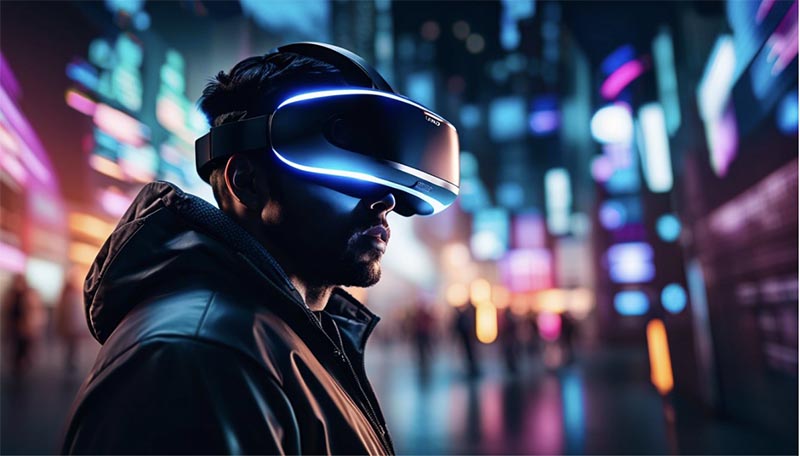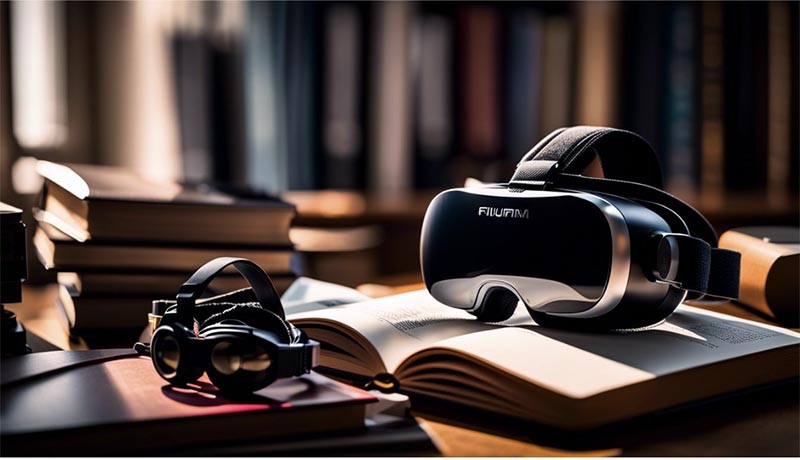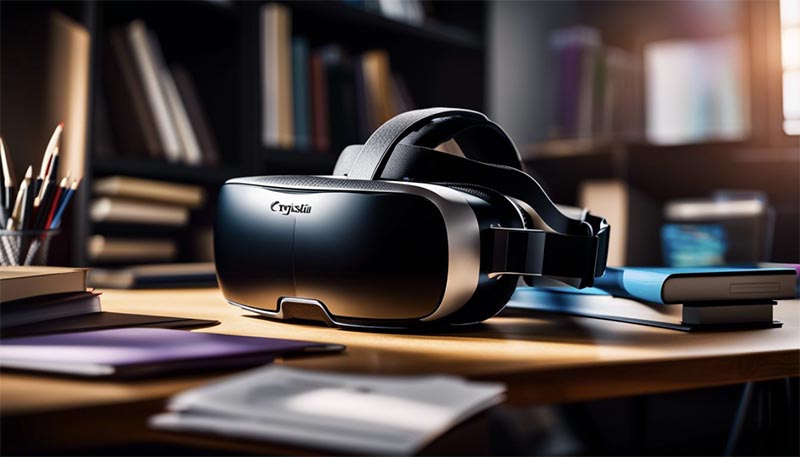Ever wondered how technology could enhance your literary adventures? Emerging trends show that Virtual Reality (VR) is radically transforming the reading experience. This article will delve into how VR combined with literature opens up immersive worlds, intensifies emotional responses, and revolutionizes learning.
Ready to embark on this exciting journey into virtual storybooks?
Understanding Virtual Reality (VR)

Virtual Reality, also known as VR, is a digital technology that has opened up new frontiers in the world of education. It’s an immersive experience that uses VR glasses or headsets to transport users into a computer-generated environment.
This 3D tool offers realistic images, sounds, and other sensations that simulate a user’s physical presence in this virtual or imaginary setting.
This robust technology significantly enhances learning experiences by turning traditional methods on their heads. Instead of reading about historical facts or scientific theories, students using VR can virtually step into these worlds, experiencing them firsthand, leading to a deeper understanding and retention of information.
Virtual reality has found its place not only in the game industry but also in fields such as the medical industry for high-tech training and literature for immersive storytelling.
The Intersection of VR and Literature

Enhanced reading experience
Virtual Reality (VR) is redefining how we consume literature, offering an enhanced reading experience like no other. The technology immerses readers in the narrative by creating a virtual model of the book’s setting -no longer limited to visualizing scenes in our minds; VR fills gaps and brings every detail vividly to life.
This impactful immersion engages users on an emotional level, transforming mere spectators into active participants within their favourite narratives.
The use of VR glasses or headsets allows readers to step directly inside their beloved novels’ worlds, from Dickensian London to futuristic dystopias. These novel settings in VR not only foster an innovative interaction with text but also provide a profound sense of presence that rivets students’ attention, hence fostering comprehensive understanding and information retention in learning settings.
With its innate ability to elicit emotional responses and stimulate creativity, VR is revolutionizing literature education and shaping the future of interactive storytelling.
Immersive storytelling
Immersive storytelling is changing the narrative landscape by introducing a level of engagement previously unattainable in traditional formats. In this innovative realm, Virtual Reality (VR) and literature intersect to provide an enhanced reading experience that leaps beyond the pages right into readers’ realities.
This fusion enables authors to create multidimensional narratives, like hyperfiction, where storylines progress not linearly but through interconnected webs akin to hypertexts conceptualized by Ted Nelson.
Herein lies Michael Joyce’s contribution: Storyspace – designed specifically for creating hyperfiction.
Further expanding on immersive storytelling, VR technology allows stories such as “Afternoon, A Story” to be brought vividly to life; each scene crafted in virtual space can make readers feel like they’re part of the narrative rather than mere observers at its edge.
The software provides multiple viewpoints and voices, enhancing emotional response and stimulating creativity with its non-linear interactive electronic literature design. Thus proving how VR revolutionizes our approach towards understanding novels and their settings via visual representation.
How VR is Revolutionizing the Reading Experience
VR revolutionizes the reading experience by providing a better sense of the environment, allowing for scaled learning experiences, evoking emotional responses, fostering creativity, and facilitating visual learning.
Better sense of the environment
Virtual Reality (VR) provides students with a better sense of the environment, allowing them to fully immerse themselves in a virtual world. By putting on VR goggles or glasses, students can explore and interact with subjects that would be difficult to experience in real life.
They can visit historical landmarks, dive deep into the ocean, or even travel to outer space. This immersive experience enhances their understanding and knowledge by providing a visual representation of complex concepts.
For example, in a biology class, students can take a virtual tour of the human body and see how different organs function together. This hands-on approach not only improves comprehension but also makes learning more engaging and memorable for students.
Scale learning experiences
VR in education has the incredible ability to scale learning experiences, providing students with opportunities that may not be accessible otherwise. Through virtual reality, students can explore and interact with environments that are difficult or even impossible to visit in real life.
For example, they can travel back in time to ancient civilizations or explore the depths of the ocean without leaving their classroom. This immersive and hands-on approach allows for a deeper understanding of concepts and fosters curiosity and engagement among students.
Additionally, VR can provide a virtual laboratory where students can practice experiments and simulations, allowing them to refine their skills and knowledge in a safe and controlled environment.
Emotional response
VR education elicits emotional responses from students, making the learning experiences more memorable and engaging. When students are immersed in a virtual environment, they feel like they are truly part of the experience, which evokes strong emotional reactions.
For example, when studying history, students can walk through ancient civilizations or
witness significant historical events. This creates a sense of empathy and connection that traditional classroom learning cannot provide.
The emotional impact enhances retention and understanding as it makes the information more personal and relatable for students. Additionally, VR allows educators to create simulations where students can experience real-world scenarios that prompt emotional responses – such as problem-solving under pressure or dealing with challenging situations – allowing them to develop critical thinking skills in a safe and controlled environment.
Develop creativity
VR technology provides students with tools and platforms to develop their creativity. Through virtual reality, students can explore and experiment with various artistic mediums in a three-dimensional space.
For example, Tilt Brush allows users to paint and create in a virtual environment, giving them the freedom to express themselves in ways not possible in traditional art forms. This fosters imagination and encourages innovative thinking as students push the boundaries of what is possible in the digital realm.
VR also enables collaboration, allowing students to work together on creative projects and share ideas seamlessly across distances. By integrating VR into education, we can unlock the full potential of students’ creativity and nurture a new generation of artists and innovators.
Visual learning
Visual learning is a key advantage of incorporating virtual reality (VR) technology in education. VR allows students to see and visualize complex concepts, functions, or mechanisms that may be difficult to understand through traditional methods alone.
With the help of VR headsets and tools like Tilt Brush, students can explore three-dimensional models that bring their learning material to life. This immersive visual experience enhances comprehension and retention, making it particularly beneficial for visual learners who thrive on seeing information in action.
By bridging the gap between theory and practice, VR technology revolutionizes the way students absorb knowledge.
Integration of VR in Literature Classrooms

VR is being integrated into literature classrooms to provide virtual excursions, high-tech training, group education, and distance learning opportunities for students.
Virtual excursions
Virtual excursions offer a deeply immersive sense of place and time, allowing users to explore virtually impossible-to-reach locations. With the help of VR technology, users can visit historical sites, natural landscapes, and cultural landmarks without leaving the classroom. Some key facts about virtual excursions include:
- Google Expeditions is an app that provides virtual excursions to various destinations around the world.
- Virtual excursions allow students to experience places and cultures they may never have the opportunity to visit in real life.
- These experiences can enhance understanding and appreciation for different subjects, such as geography, history, and literature.
- Virtual excursions provide a safe and controlled environment for learning, free from physical hazards or limitations.
- Students can interact with the virtual environment by examining objects or artifacts, answering questions, and participating in guided activities.
- Virtual excursions can be customized to align with specific learning objectives or curriculum standards.
- The immersive nature of virtual excursions can spark curiosity and engagement among students, making the learning experience more memorable and impactful.
- Studies have shown that virtual excursions can improve student retention rates and comprehension compared to traditional classroom instruction alone.
High-tech training
High-tech training is one of the many ways virtual reality (VR) is revolutionizing education. With VR technology, students can have immersive experiences in various fields, such as medical training and career exploration.
Medical students can use VR to study anatomy in a three-dimensional space, gaining a deeper understanding of the human body. This high-tech training allows for hands-on learning without the need for physical specimens or cadavers.
Similarly, VR can provide students with the opportunity to explore different careers by simulating a typical workday and allowing them to experience firsthand what it’s like to be in that profession.
Group education
Group education in virtual reality (VR) is a powerful tool that enhances collaboration and fosters meaningful learning experiences. With VR technology, students can come together in a virtual environment to interact with each other and their surroundings, regardless of physical location.
This allows for dynamic group discussions, cooperative problem-solving, and shared exploration of educational content. By immersing students in a collaborative VR setting, educators can promote active engagement and social interaction among learners while facilitating a deeper understanding of complex concepts.
However, not all learners might have access to VR technology or might prefer a more traditional online learning environment. For those who are looking to complement their VR learning experiences or seek alternative methods, Online Courses are a fantastic resource.
Distance learning
Distance learning has become increasingly popular in recent years, allowing students to learn from the comfort of their own homes. And now, with the integration of virtual reality (VR), distance learning is taking on a whole new level of engagement and immersion.
With VR technology, students can enter virtual classrooms and interact with teachers and peers as if they were physically present. This not only creates a more collaborative learning environment but also allows for customizable learning experiences that cater to each student’s needs.
Moreover, VR in distance learning opens up opportunities for students who may not have access to certain resources or educational institutions. It bridges the gap between geographical limitations and provides equal access to quality education for all.
The Role of Teachers in VR Education

Teachers play a crucial role in integrating VR technology into education. They are the facilitators who guide students through the immersive learning experiences provided by VR.
Teachers need to be trained on how to effectively use VR tools and software, as well as how to create engaging and educational virtual environments.
They also need to adapt their teaching methods to incorporate VR technology, ensuring that it aligns with curriculum objectives and enhances student understanding.
In addition, teachers act as mentors, providing support and guidance during the VR experience. They can help students make connections between what they see in the virtual world and real-world concepts, facilitating deeper comprehension.
Furthermore, teachers can encourage collaboration and communication among students while using VR, promoting active engagement in learning.
Overall, teachers are essential for successful integration of VR into education. Their expertise in subject matter combined with their knowledge of pedagogy allows them to maximize the benefits of VR technology for student learning outcomes.
Advantages of VR in Literature
VR in literature offers accessibility to a wider range of readers and opens up new horizons for storytelling.
Accessibility
Virtual Reality (VR) technology is revolutionizing the reading experience by making literature more accessible to a wider audience. VR allows individuals with physical disabilities or limitations, such as visual impairments, to fully engage with literary works through immersive experiences.
With VR glasses or goggles, readers can explore virtual models of book settings and characters in a way that was previously inaccessible. This inclusivity expands the reach of literature and opens up new horizons for all readers, regardless of their abilities.
Opening new horizons
VR in literature is opening new horizons for readers and students alike. It allows individuals to explore literary worlds in a whole new immersive way, breaking down the barriers of traditional reading experiences.
With VR technology, readers can step into the pages of their favorite books and experience the settings, characters, and events firsthand. This not only enhances their understanding and engagement with the story but also expands their imagination and creativity.
VR opens up a world of possibilities where stories come to life, making literature more accessible and exciting for all.
Conclusion
In conclusion, virtual reality is revolutionizing the reading experience by breaking down barriers and immersing readers in an interactive world of literature. With enhanced environments, emotional responses, and limitless creativity, VR has the potential to transform education and open new horizons for readers everywhere.
As VR technology continues to advance, it’s clear that the future of literature is unbound and full of exciting possibilities.
FAQs
1. What is virtual reality and how is it revolutionizing the reading experience?
Virtual reality (VR) is a technology that immerses users in a simulated environment, allowing them to interact with digital content as if they were physically present. VR enhances the reading experience by creating immersive literary worlds where readers can visually explore settings, interact with characters, and even participate in the narrative.
2. How does virtual reality impact reader engagement and immersion?
Virtual reality enhances reader engagement and immersion by providing visual and auditory stimuli that deepen the connection to the story. Readers can feel like they are part of the narrative, experiencing events firsthand, and forming emotional connections with characters through realistic simulations.
3. Are there any potential drawbacks or challenges associated with virtual reality in literature?
While virtual reality offers exciting opportunities for enhancing the reading experience, there are some potential challenges to consider. These include issues of accessibility for readers who may not have access to VR technology or have physical limitations that prevent their full participation. There may also be concerns about maintaining literary integrity when incorporating interactive elements into traditional narratives.
4. How can authors and publishers incorporate virtual reality into their works?
Authors and publishers can incorporate virtual reality into their works by collaborating with developers or studios specializing in VR experiences. They can design immersive environments, create interactive storytelling elements, and adapt existing literature into VR-compatible formats. Additionally, authors can explore new narrative possibilities unique to virtual reality storytelling techniques, such as branching storylines or multiple perspectives.
An internationally accredited book blogger, voracious reader and the founder of Booxoul, one of India’s leading book and lifestyle blogs, Neelam is a person with a penchant for bringing out the best in people. A website designer, a renowned book blogger and a leading creative influencer on Instagram, here is a lady who is candid, closer to life and sensitive to the softest of emotions…
A Book Blogger, Reviewer, a true friend, honest critique, a relentless benefactor and more…

